 |
 |
 |
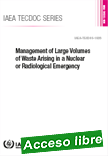 |
Management of Large Volumes of Waste Arising in a Nuclear or Radiological Emergency
IAEA TECDOC, 2017, 102 p.
This publication, prepared in light of the IAEA Action Plan on Nuclear Safety developed after the accident at the Fukushima Daiichi nuclear power plant, addresses the management of large volumes of radioactive waste arising in a nuclear or radiological emergency, as part of overall emergency preparedness. |
The management of large volumes of waste will be one of many efforts to be dealt with to allow recovery of affected areas, to support return of evacuated or relocated populations and preparations for normal social and economic activities, and/or to mitigate additional environmental impacts. The publication is intended to be of use to national planners and policy makers, facility and programme managers, and other professionals responsible for developing and implementing national plans and strategies to manage radioactive waste arising from nuclear or radiological emergencies.
Executive summary: http://www.oecd-nea.org/rp/pubs/2018/7436-all-hazards-epr-es.pdf |
 |
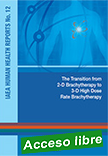 |
The Transition from 2-D Brachytherapy to 3-D High Dose Rate Brachytherapy: Training Material
IAEA Training Course Series (CD-ROM), No. 61
Brachytherapy is a major treatment modality in the treatment of common cancers including cervical cancer. This publication addresses the recent technological change in brachytherapy treatment planning with better access to 3-D volumetric patient imaging modalities including computed tomography (CT) and magnetic resonance (MR) as opposed to traditional 2-D planar images. |
In the context of 2-D and 3-D brachytherapy, the publication provides definitions, clinical indications, transitioning milestones, commissioning steps, quality assurance measures, and a related questionnaire. Staff training and resourcing are also addressed. The publication will serve as a guide to radiotherapy departments that wish to make the transition from 2-D to 3-D brachytherapy.
Extraído de: http://www-pub.iaea.org/books/IAEABooks/10705/The-Transition-from-2-D-Brachytherapy-to-3-D-High-Dose-Rate-Brachytherapy
Extraído de: https://www-pub.iaea.org/MTCD/Publications/PDF/TCS-61-CD.zip |
 |
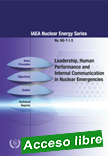 |
Leadership, Human Performance and Internal Communication in Nuclear Emergencies
IAEA Nuclear Energy Series, 2018, 36 p.
This publication focuses on the challenges and their possible solutions in the areas of leadership, human performance and internal communication in a severe nuclear emergency. It presents a brief overview of some of the key concepts, especially how they relate to an organization’s ability to successfully manage an emergency event.
|
The target audience for this publication are those officials and senior managers dealing with emergency response in the operating organization, government, local authorities and the regulatory body. Those who have an influence on the style of leadership and personnel development and training that is applied in their organizations and who are involved in emergency preparedness and response will also benefit from this publication.
Extraído de: https://www-pub.iaea.org/books/IAEABooks/11100/Leadership-Human-Performance-and-Internal-Communication-in-Nuclear-Emergencies |
 |
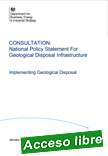 |
The purpose of this consultation is to gather views on whether the draft National Policy Statement (NPS) for Geological Disposal Infrastructure (GDF) provides an appropriate and effective framework for the Planning Inspectorate and the Secretary of State to examine and make decisions on development consent applications for geological disposal infrastructure in England.
|
National Policy Statements set out the need for particular Nationally Significant Infrastructure Projects (NSIPs), and are required, under the Planning Act 2008, to undergo a period of public consultation before they are published.
This consultation applies to residents of England and Northern Ireland.
Extraído de: https://www.gov.uk/government/consultations/national-policy-statement-for-geological-disposal-infrastructure
|
 |
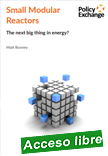 |
Small Modular Reactors - The next big thing in energy?
Policy Exchange (UK), 2017, 44 p.
Small modular nuclear reactors could be a crucial technology in the drive to decarbonise our energy system, according to Small Modular Reactors: The next big thing in energy? published on Thursday by Policy Exchange.
The increased take-up of electric vehicles, the general electrification of our energy system and the need to decarbonise all sectors of our economy mean we need new low carbon sources of electricity and heat to replace existing capacity and meet rising future demands. |
The diffuse and intermittent nature of solar and wind means that we cannot rely on them for 100% of our energy needs – for example, January typically sees at least one week where virtually no electricity is produced by either wind or solar compared with what is needed. Buying in electricity through interconnectors from other Western European nations will be increasingly difficult as our neighbours also turn to wind and solar and so have less capacity to export, while the battery storage capability to back up renewables could cost up to £1 trillion.
We need a reliable and affordable low carbon form of energy – small modular reactors have the potential to be that technology.
Policy Exchange’s recommendations include: Use SMRs as part of our energy mix to reduce the system costs of decarbonisation, thereby reducing consumer bills in the long term;
The Government should proceed swiftly with the development of at least one third generation (Gen III) small modular reactor design after the results of their current consultation are published; Launch a consultation with heavy industry into what services advanced fourth generation (Gen IV) reactor designs could also bring that would be of use to them, like hydrogen production to use in low carbon steel manufacturing; SMR producers should prepare for hydrogen to become a larger part of our economy, from replacing the gas currently supplied to homes for heating to powering a new generation of low-carbon vehicles. This means developing the technology to create hydrogen using nuclear power; The Government should also commission polling of populations closest to potential sites for SMRs to inform decisions on where they are located; SMR producers should plan to make the most of nuclear capacity, heating nearby homes with the excess water currently pumped into the sea and developing storage battery storage to ensure the most efficient use of power generated.
Extraído de: https://policyexchange.org.uk/publication/small-modular-reactors-the-next-big-thing/
|
 |
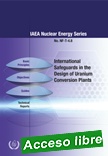
|
International Safeguards in the Design of Uranium Conversion Plants
IAEA Nuclear Energy Series, 2017, 36 p.
This publication is the fourth in the IAEA Nuclear Energy Series to provide guidance on the inclusion of safeguards in nuclear facility design and construction. It is principally intended for designers and operators of conversion plants; |
however, vendors, national authorities and financial backers can also benefit from the information provided. The publication complements the general considerations addressed in International Safeguards in Nuclear Facility Design and Construction, IAEA Nuclear Energy Series No. NP-T-2.8.
Extraído de: http://www-pub.iaea.org/books/IAEABooks/10759/International-Safeguards-in-the-Design-of-Uranium-Conversion-Plants
|
 |
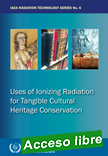 |
Uses of Ionizing Radiation for Tangible Cultural Heritage Conservation
IAEA Radiation Technology Series, 2017, 241 p.
The preservation of world cultural heritage is a key issue for maintaining national identity and understanding the influences or exchanges among civilizations throughout history. Development of appropriate preservation techniques that do not compromise longevity or authenticity are therefore of utmost importance.
|
Radiation techniques have demonstrated significant success in the disinfestation and preservation of cultural heritage artefacts, and national and international research programmes have developed harmonized methodologies for such radiation treatment. This publication provides state of the art knowledge on radiation technology applied to the conservation and consolidation of items of cultural heritage and will be of use to collection curators, conservators, restorers, registrars, art historians, archaeologists and conservation scientists active in the various fields of cultural heritage in museums, libraries, archives, archaeological institutions, historical buildings and conservation workshops.
Extraído de: http://www-pub.iaea.org/books/IAEABooks/10937/Uses-of-Ionizing-Radiation-for-Tangible-Cultural-Heritage-Conservation |
 |
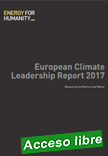 |
European Climate Leadership Report 2017 - Measuring the Metrics that Matter
Energy for Humanity, November 2017, 64 p.
The new report ranks European countries on their climate leadership using official Eurostat data and exclusive data from ElectricityMap.org.
The European Climate leadership 2017 report proposes 3 new metrics to measure climate leadership:
Total carbon dioxide emissions per GDP in 2010 as baseline (leader: Switzerland)
Absolute carbon dioxide reductions from 2010 to 2015 for measuring recent net progress (leader: UK)
|
Average annual decarbonisation rate from 2010 to 2015 measuring how fast countries are “greening” their economy (leader: Poland)
The key findings are: Germany’s much-vaunted “Energiewende” programme has made things worse for the climate by shutting down carbon free nuclear capacity and locking in the dependency on coal burning for decades, despite hundreds of billions in investments and subsidy-schemes. In terms of absolute greenhouse gas emissions, Germany is by far the largest emitter in Europe (EU-28 plus EFTA plus Turkey). Germany alone emits 18 per cent of total emissions. Germany is not decarbonising as fast as other large emitters (14th of 23 countries analysed). Furthermore, by exporting electricity generated by fossil fuels, Germany is significantly increasing the CO2-intensity of neighbouring countries’ electricity consumption.
Climate leaders are countries with hydro-power resources and strong policies to support nuclear energy, alongside renewables. These countries include Switzerland (hydro and nuclear), Norway (hydro) and Sweden (hydro and nuclear). In contrast, antinuclear Austria backs up its hydro capacity with fossil fuels, driving down its overall climate performance.
Countries that have pragmatic yet ambitious climate and energy policies, such as the UK, are driving down their emissions. The UK has achieved the largest absolute reduction in GHG emissions in Europe from 2010-2015. Some Eastern Europe countries like Poland, Slovakia and Czech Republic, have also decreased their high emissions levels significantly in the recent years while growing their economies.
For the first time, the data accounts for cross-border flows of carbon emissions. Importing dirty electricity impacts the carbon intensity of electricity consumption in some countries. The report strongly recommends that policy makers take imports and exports into account.
A high percentage of installed new renewable capacity does not guarantee low CO2emissions.
Extraído de: http://energyforhumanity.org/en/resources/downloads-en/european-climate-leadership-report-2017-measuring-the-metrics-that-matter/
|
 |
|
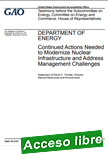
|
Department of Energy: Continued Actions Needed to Modernize Nuclear Infrastructure and Address Management Challenges
Government Accountability Office (GAO - US), February 6, 2018, 35 p.
Department of Energy’s (DOE) National Nuclear Security Administration (NNSA) is responsible for managing the nuclear weapons stockpile and supporting nuclear nonproliferation efforts.
|
DOE’s Office of Environmental Management’s misión includes decontaminating and
decommissioning facilities that are contaminated from decades of nuclear weapons production.
Over the last few years, GAO has reported on a wide range of challenges facing DOE and NNSA. These challenges contribute to GAO’s continuing inclusion of DOE’s and NNSA’s management of major contracts and projects on the list of agencies and program areas that are at high risk of fraud, waste, abuse, and mismanagement, or are in need of transformation. GAO also recently added the U.S. government’s environmental liabilities to this list. This statement is based on 25 GAO reports issued from April 2011 through January 2018 and discusses (1) challenges related to the affordability of NNSA's nuclear modernization plans;
(2) challenges related to DOE’s environmental liability; (3) the status of DOE’s efforts to improve its management of contracts, projects, and programs; and (4) challenges
facing NNSA’s nonproliferation programs.
Testimony: https://www.gao.gov/products/GAO-18-374T
Highlights: https://www.gao.gov/assets/690/689889.pdf
Report: https://www.gao.gov/assets/690/689889.pdf
|
 |
 |
Consultation: Working With Communities - Implementing Geological Disposal
Department for Business, Energy & Industrial Strategy (UK), 25 January 2018, 64 p.
This consultation is seeking views on how communities should be engaged and represented in a siting process for a geological disposal facility for higher activity radioactive waste.
|
The proposals build on commitments set out in the 2014 White Paper ‘Implementing Geological Disposal’, in which the UK Government and Northern Ireland Executive jointly set out an approach based on working with communities in England and Northern Ireland that are willing to participate in the siting process for a geological disposal facility. They relate to how communities should be represented, how early community investment could be provided to communities that participate in the siting process, how a right of withdrawal could operate
throughout the siting process and how a test of public support could be carried out before construction and operation of a geological disposal facility.
Views are being sought on the proposals set out in this consultation document. Specific questions for respondents to consider are included throughout the document, and are listed together in Chapter 6.
Once this consultation has closed, the Government will consider comments received and publish a summary of the consultation responses and final policy decisions. The delivery body will produce more detailed guidance on how the siting process will work in practice
.
Extraído de: https://www.gov.uk/government/uploads/system/uploads/attachment_data
/file/676391/WWC_consultation.pdf
|
 |
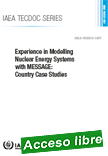 |
Model Regulations for Borehole Disposal Facilities for Radioactive Waste
IAEA TECDOC, 2017, 48 p.
This publication is designed to assist in the development of an appropriate set of regulations for the predisposal management and disposal of disused sealed radioactive sources and small volumes of associated radioactive waste using the IAEA borehole disposal concept.
|
|

|
|
|
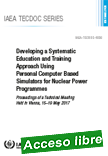 |
Industrial Applications of Nuclear Energy
IAEA Nuclear Energy Series, 2017, 80 p.
This publication provides a detailed overview of the potential use of nuclear energy for industrial systems and/or processes which have a strong demand for process heat/steam and power, and on the mapping of nuclear power reactors proposed for various industrial applications.
|
It describes the technical concepts for combined nuclear–industrial complexes that are being pursued in various Member States, and presents the concepts that were developed in the past to be applied in connection with some major industries. It also provides an analysis of the energy demand in various industries and outlines the potential that nuclear energy may have in major industrial applications such as process steam for oil recovery and refineries, hydrogen generation, and steel and aluminium production. The audience for this publication includes academia, industry, and government agencies.
Extraído de:http://www-pub.iaea.org/books/IAEABooks/10979/Industrial-Applications-of-Nuclear-Energy
|
| |
| |
|
|
| |
| |
|
|
| |
| |
|
|
|
